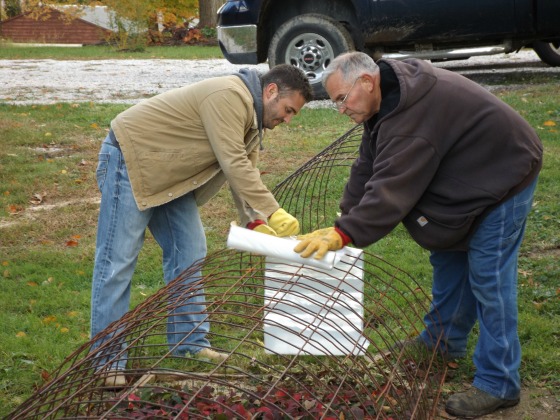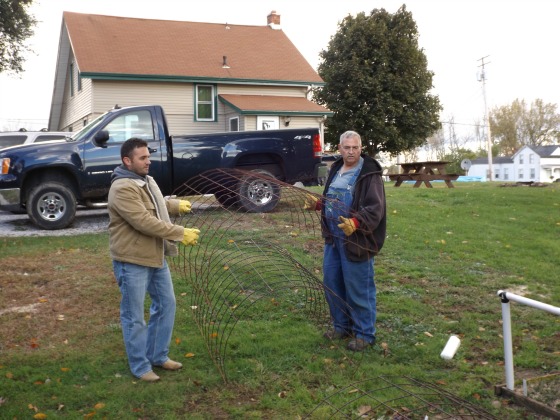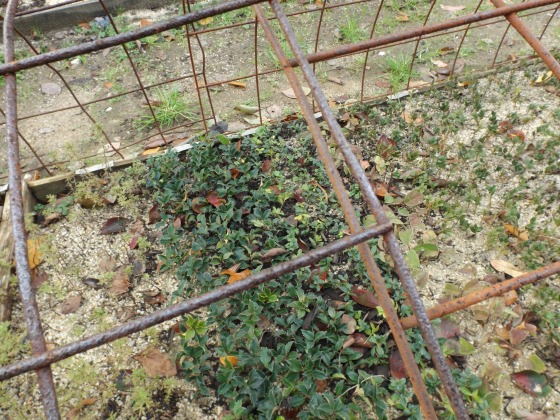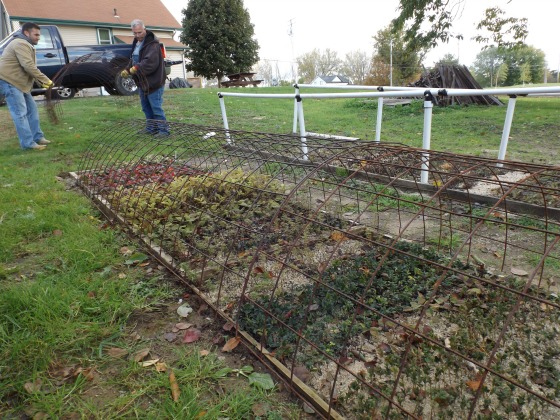Many people think they are limited in what they can grow because they don’t have a greenhouse. As long as you are growing plants that are hardy to your gardening zone, your plants will be okay outside over the winter.
Plants in the ground rarely need to be covered for the winter. They will freeze, but that is okay. Their roots stay constantly moist in the ground soil.
Plants in pots dry out much faster than plants in the ground. Harsh winter winds speed up the drying process. It’s a good idea to protect your potted plants from the wind to keep the roots from drying.
We used our hoop house to cover some small plants that we were propagating as softwood cuttings.
Hoop houses are a simple way to protect your potted plants from drying winter winds.
You can build a simple, durable hoop house out of concrete reinforcing mesh. You can find it at most home improvement stores, such as Lowes, Home Depot or Menards.
It is used to strengthen concrete in sidewalks and driveways. They are sold in flats sheets or on rolls. It’s best to get a roll so that it will already be bent into a round shape.
We’ve seen homemade hoop house designs made from PVC piping or livestock fencing. Concrete reinforcing mesh is heavy-duty. It will last you many years and can stand up to a heavy snowfall.
Check out these pictures of a large metal hoop house that collapsed under heavy snowfall. Concrete reinforcing mesh will not collapse.
We used 7 ft pieces of mesh and cut them to fit nicely over our propagation bed. Small bolt cutters worked really well for snipping the thick wires.
When we made each cut, we cut through the middle of a square. The protruding wires made handy little stakes for securing each section into the ground.
Once your frame is in place, your hoop house is ready to be covered. This is very important:
Do not cover your plants until they have gone dormant!
Your plants need several hours of freezing temperatures to trigger them into dormancy. Dormancy is a period of rest for your plants.
Like a bear in hibernation, your plants will sleep and slow their metabolism. This helps get them to survive the cold, dry winter months.
Once your plants have gone dormant, cover your frame with 6mil WHITE plastic sheeting. White sheeting is sold in nursery supply stores. You are not likely to find it in at a hardware store.
Most hardware stores carry clear or opaque sheeting. If you cannot find white sheeting then paint it white with latex paint.
It must be white. It must be white. It must be white.
White sheeting will reflect the suns rays. Clear, black or opaque sheeting will heat up your plants during the day. Your plants must stay dormant for the winter.
You don’t want them heating up during the day and breaking dormancy. Then they have to fight to stay alive in freezing temperatures at night. Its too much stress on your plant. They must stay dormant.
The purpose of a hoop house is to block the drying winds, not to keep them warm. Hoop houses don’t have ventilation or heat. They do not create an artificial environment like a greenhouse.
Give your plants a good watering before you put on the plastic.
Large hoop houses, like the ones found at most nurseries, are designed to be opened and closed. They are large enough to allow tractors and workers inside.
It is hard to maintain humidity in all that open space and with workers coming and going so large hoop houses have irrigation lines installed so they can water the plants every 3 weeks or so….the irrigation lines have to be winterized…its a lot of work.
Short hoop houses have less dead air space and allow for more humidity. They are designed to be closed tightly all winter.
If you give your plants a good watering before tucking them away for the winter, they should be fine until spring. If you are concerned that they might need more water, you can poke a small hole in the plastic and spray some water in with a hose.

Cover your hoop house with one layer of white plastic sheeting. Pull it tight and make sure there are no gaps.
Leave about 18 inches of plastic all the way around and weigh it down on all four edges with sand or soil. We prefer sand because the soil is a muddy mess come spring.
Do not use bricks or lumber to hold your plastic in place. Trust me. Been there, done that, it doesn’t work! Wind will find its way in and tear your plastic.
Here is a helpful hint:
You can put large potted plants inside a small hoop house by placing them on their sides. Prop the first row up so they sit at a slightly diagonal angle.
This will keep the soil from falling out of the pot. Prop your next row of plants up against the first.





Hi Mike, can you store wintered plants in sand, covered with white plastic, to stop the roots from drying out?
You could, but being covered the sand might dry out even more. My rooted cuttings in a bed of sand I just leave uncovered all winter. I should water them when it’s warm and dry but I don’t often and probably pay a price for that. I think covering the sand would make it worse.
Thank you for the very helpful article, Mike. Two questions: 1- How wide is your propagation bed? 2- How wide is the cattle panel fencing?
Thank you in advance for your response and for sharing your knowledge.
Mike
My beds are usually about 42″, the fencing is 48″.
The fence to make the hoop is I think 8 to 10 feet but you better measure to be sure.
Hello Mike,
Thank you for these measurement.
Mr. McGroarty or Mike, excellent advise to make a Hoop and your experience given.
What a about Squarlles and rates or other animals?
Did you in Canada Federal Policy is illegal to use prefix Mr.
What an idiotic law
What about them?
Canada Federal Policy, a quick review tells me that’s simply not true.
Did you mean squirrels and rats?
Mike,
Is this also a good way to propagate rhododendrons and azaleas?
Thanks for all the great info you share
Sandra,
Azaleas are easy as softwood cuttings, Rhododendrons are usually done in the winter over bottom heat.
Happy New Year to you, your family and all your supporters Mike!
Blessing of health love and joy!
Tara
Thank you Tara!
Invest in UV restant plastic. The plastic on my little greenhouse is over seven years old and shows no sign of failture. It costs a little more but is well worth it. Just google for it online. i looked for it at the box stores but didd’nt see it. Thank You.
Dear Mike,
You have been a big help to me. Thank you.
I made your Aquarium idea and got nice rooted cuttings. I know you said to pot them or put in ground. It is Sept and I don’t want to lose them over winter(zone6). If I pot them, can I leave them in a sheltered place or can I put the aquarium back over the pots. And yes it was thrilling to see them survive( most of them), Tganks for your help. Sarah Olivito
Sarah,
Put them in a protected. Covering them with the aquarium is okay, but it might be too hot. Just placed in a protective area and kept watered when warm and dry should be fine. Or just bury the pots for the winter for extra protection.
Hi Mike,
I have several dozen Burr Oak and Horse Chestnut seedlings in one gallon pots from this year. Will this hoop house work? I’ve been told to keep them just above or just below freezing throughout the winter. Someone else advised just to bury them in sawdust outside.
Doug,
Freezing won’t hurt them but drying out and freezing will. Burying the pots would probably work fine, if not the hoop house is even better.
I have some tender pomegranate bushes in southern France I want to protect. Last year, most of my pomegranates were killed by the bark splitting and peeling back at ground level. I’m assuming this was frost damage – it gets down to to 20F.
I’ve already bought some white mesh stuff to go over the hoop house I’m planning for them. It’s woven, ventilated. It’ll stop the wind. Do you think this stuff would work, or do I need to find the white plastic?
Thanks,
John
John,
All I can say is that hundreds and hundreds of wholesale growers only use white plastic. The mesh might allow them to dry too much. You have to keep the humidity up over the winter.
I am thinking about using some hog fence panels in the same way. Will they be heavy enough or is the re-wire the better way to go? I am also using hog panels to make an arbor to run my new grape vines on instead of trellising like I did before. One panel is long enough that you can anchor the ends about six feet apart and you can walk under the arch, or put a bench under it for a nice little shaded spot near the garden.
After having a large garden in our previous 1/2 acre yard, we moved last fall and I decided to go with all raised beds to give my back a break and make weeding and tilling a lot easier. So far I have been very pleased with the results and my back thanks me every time I do gardening work. Is there any benefit to covering all my beds with a long hoop house over the winter, or are they better left alone? I am not rooting anything right now so I have no babies that need protected. The only bed that I would be worried about covering is the bed with strawberries in it, that have been covered with straw since we had a couple days in the 20’s and the leaves started to brown a bit.
David
David,
Hog pannels work great. I see no advantage to covering a garden with no tender plants in it.
All of our hoops are out of cattle panel 40″x16′. and 4panel on each bed. Being here on the Palmer Divide in Colorado , where we get snow bomb storm.. all have stood up when all the greenhouse collapsed .We put sideboards 7′ apart between 2 pieces of rebar spaced at 36″ secure it to the panel by slipping the panel inside behind the inside rebar and electrian nail it to the side boards also nail the rebar to that board.- then we tie the panels together with stainless steel zip ties- We grow the Back to Eden garden . and we thermal plastic for Tomatoes and then shade cloth one and then hail net other hail net will give you 17% shade.
The panels like hog panels but wider (taller) with uniform openings work b etter than the hog panels with closer spacing on the bottom, and shorter height. You have to buy more of the shorter hog panels, so it gets more expensive.
Concrete reinforcing mesh may be heavier gauge steel, but they rust faster.
It’s pretty easy to use these to make a little greenhouse, aka ‘high tuin n erl’ not just the low grow tunnels shown in this article. .
Tammie– There are several methods for storing your Dahlia tubers after digging them up. One is to hose them off, let them air dry, then cut the new tubers from the mother plant that have “eyes”, then wrap each new tuber in Saran Wrap, or place in baggies that have some wood shavings or peat moss. Then, store them in foam ice chests filled with peat moss.
This year (I live in WA state), I’ve opted not to hose them off, since it was so late and cold in the season. I placed them in my hoop house in the shade to dry out for a few days, then filled several plastic bins with peat moss, then placed the whole tubers in the peat moss and not touching each other. Then covered all with peat moss and placed the plastic lid on top to keep some moisture in. A couple weeks later, I saw the plastic bins were gathering what I thought might be too much moisture, so I cracked open the lids a bit. Next spring, if all goes well, the eyes should develop starting in February. Soon after, I will separate the new tubers from the mother plant and toss the mother.
A tip o.n FREE 20 mil white plastic sheeting. I get it all the time and it is super thick and free for the taking here in middle Tn. I go around to the local boat dealers (Big boats are best) and ask them to give me a call when they get some in. The boats are shrink wrapped with this great white plastic (have you seen them go by on the interstate?) and the dealer will cut it off and toss it in the dumpster so just take him a few plants and he will be glad to call you when a shipment comes in.
Great tip Robert!
This smart thinking!
Thank you
Great idea.!I go to the local truss making place and the huge tarps from the semis are free too. They are usually white on the inside and sometimes black. They are very sturdy.
Can this be done with raised garden beds?
Tim,
Sure, I don’t see why not.
Hi Mike,
How do I winterize my Dinner Plate Dahlia bulbs that I dug up? Also, can I separate the additional bulbs that grew on the original bulbs I planted. I live in Central Illinois.
Also, how do I tie the plants up so they don’t fall over? I used round green wires that has 3 prongs that go in the ground that I bought & it was not strong enough nor high enough to keep them from falling over. I figured I would have to buy at least 4 ft high bamboo posts to use, but there not very strong, so I’ll probably have to tie at least 3 to each plant. Am I correct? What can I use to tie them up with.?
Thank u for all your emails. They have helped. me a lot.
God Bless & Merry Christmas to u & your Family.
Tammie,
Dinner plate hibiscus over winter just fine in the ground. Dahlia I don’t know about. Use lightweight fence posts in you need that kind of support.
Tammie– There are several methods for storing your Dahlia tubers after digging them up. One is to hose them off, let them air dry, then cut the new tubers from the mother plant that have “eyes”, then wrap each new tuber in Saran Wrap, or place in baggies that have some wood shavings or peat moss. Then, store them in foam ice chests filled with peat moss.
This year, I’ve opted not to hose them off, since it was so late and cold in the season. I placed them in my hoop house to dry out for a few days, then filled several plastic bins with peat moss, then placed the whole tubers in the peat moss and not touching each other. Then covered all with peat moss and placed the plastic lid on top to keep some moisture in. A couple weeks later, I saw the plastic bins were gathering what I thought might be too much moisture, so I cracked open the lids a bit. Next spring, if all goes well, the eyes should develop starting in February. Soon after, I will separate the new tubers from the mother plant and toss the mother.
Dahlias must be kept above freezing temperatures during winter. Keep them in your unfinished basement.
I kept my dahlia tubers in the house in a bucket with sawdust so they didn’t touch each other
didn’t work .. cuz the temps were too high in the house?
no basement or ‘cool room’ so I gave up on dahlias
Good morning Mike,
I planted strawberries this spring in rain gutters. I have 4 rows that are 41′ in length. What is the best way to help them through the winter? I can not really put straw on them. I thought about bubble wrap them but read that need white plastic. Now thinking about getting white plastic and wrap them from top to under gutters to top again. .Is that the best way? I have soaker hose inside the gutter. Reading it says to water before covering them up as well. I would like to send a picture to you of what I have if that would help. But this part of paragraph would not let me copy and paste a picture.
Your help would be greatly appreciated.
Thanks,
Tony
Tony,
I really don’t know what would be best. All I can say is the closer to the ground they are the better. But I will say this, strawberries are pretty tough, pretty winter hardy, they might be okay uncovered but I can’t say that for sure.
Here in Virginia Beach, some of our commercial berry growers just leave them uncovered & they make it. Perhaps a little later, but still quite productive.
Hello, Mike, good article about the mesh hoop house. But a question in regard to dormancy. The article says “Your plants need several hours of freezing temperatures…”Living in north Florida I didn’t even see 32 degrees last winter. So when would I cover my plants under the hoop?
Claude,
Covering in your zone might not be a good idea. Around here we start uncovering as soon as the temps get up near 50 degrees F. Covering in your climate might do more harm than good. My question is what do growers around you do?
Hi Mike! I propagated 100 blue fescue this summer that are doing beautifully in a raised bed with 10″ of soil. But the bed is open below. (It looks like an old cattle feed trough.) Should I transplant the fescue into the ground before a hard freeze or cover them in the raised bed? Thanks so much! Love your posts which have helped bunches.
Marilyn,
I would prefer to see them in the ground. All that cold air beneath them is not a good idea. Not only will they be really cold, but they will dry easily as well.
Years ago, I built a reinforcement mesh mini-greenhouse. A small pair of bolt cutters are useful for cutting the mesh, and vise grips for bending and wrapping the cut ends where you want them.
Depending on how you cut the mesh, the ends may be razor sharp – so wearing gloves is a good idea.
The reinforcement mesh makes nice tomato cages, too.
AC,
You’re right about the bolt cutters and the jagged edges. You have to be careful when cutting that the loose end of the roll doesn’t come back and hit you in the back.
“MAJOR SAFETY ISSUE” IT IS BEST TO HAVE TWO PEOPLE WHEN UNROLLING AND CUTTING . IT DOSEN’T HIT, IT CAN IN-PAIL YOU. IT TENDS TO HAVE A MEMORY LIKE RUBBER.
how wide is the bed you are covering? (how tall is the hoop house at center)
how big are the sqares in the concrete mesh (how much will be sticking in the ground….)
which will then tell us how wide is the plastic sheeting (exposed hoop + 18 + 18″ on sides)
if you use sand/soil to hold down the edges, what the heck do you do with it in spring? would “snake” sandbags work here? or roll the edges onto pvc and then sandbag those?
Hey Mike,
Any advice on digging the bed a foot below ground level to place pots? I’m digging out a 10×3 trench that I’ll either use lumber and rebar to frame and leave below ground to store pots for winter or fill with well draining soil.
I’ll use your mesh recommendation for the hoop house just asking how you do your beds?
This is important. In order to make recessed beds like I use for over wintering containers you ABSOLUTELY, POSITIVELY, MUST HAVE WELL DRAINED SOIL. I recess my beds anywhere from 8″ to 16″ below grade then shore up the sides with one by four material secured with EMT (electrical conduit). But if your soil cannot take large amounts of water and accept it quickly, sunken beds will not work. Very few people have the advantage of well drained soil like I do.